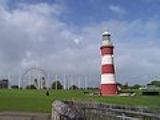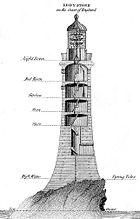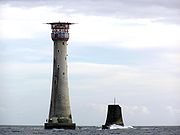
Smeaton's Tower
Encyclopedia
Smeaton's Tower is the third and most notable Eddystone Lighthouse
. It marked a major step forward in the design of lighthouses. In use until 1877, it was largely dismantled and rebuilt on Plymouth Hoe
in the city of Plymouth
, Devon
where it now stands as a memorial to its designer, John Smeaton
, the celebrated civil engineer
.

 Smeaton was recommended to the task by the Royal Society
Smeaton was recommended to the task by the Royal Society
and he modelled the shape of his lighthouse on that of an oak tree, using granite blocks. He pioneered the use of "hydraulic lime
," a form of concrete that will set under water, and developed a technique of securing the granite blocks together using dovetail joints and marble dowels.
Construction started in 1756 at a site in Millbay
where Smeaton built a jetty and workyard in the south west corner of the harbour for unloading and working the stone. Timber rails of 3 ft. 6 in. gauge were laid for the four-wheeled flat trucks on which the masonry was moved around the site. A ten-ton ship, named the Eddystone Boat, was based here and took the worked stones out to the reef. She carried the 2¼ ton foundation stone out in the morning of 12 June 1756.
The work was completed in August 1759, at a cost of £40,000. Many of the men employed in the construction were Cornish tin miners, and to avoid the possibility of press ganging
, which was rife at the time, Trinity House
arranged with the Admiralty
in Plymouth that each man was issued with a medal to confirm that they were working on the lighthouse.
The upper part was dismantled and rebuilt as a memorial to Smeaton on a new base on Plymouth Hoe
in 1882, replacing the triangular obelisk that had been built there by Trinity House as a navigation aid in the early 19th century. It was opened to the public by the Mayor of Plymouth on 24 September 1884.
However the foundations and stub of the old tower remain on the Eddystone Rocks, close to the current lighthouse; the foundations proved too strong to be dismantled so the Victorians left them where they stood. The irony of this lighthouse is that although the previous two were destroyed, this one proved to be stronger than the rock upon which it was built and could not be intentionally dismantled.
Eddystone Lighthouse
Eddystone Lighthouse is on the treacherous Eddystone Rocks, south west of Rame Head, United Kingdom. While Rame Head is in Cornwall, the rocks are in Devon and composed of Precambrian Gneiss....
. It marked a major step forward in the design of lighthouses. In use until 1877, it was largely dismantled and rebuilt on Plymouth Hoe
Plymouth Hoe
Plymouth Hoe, referred to locally as the Hoe, is a large south facing open public space in the English coastal city of Plymouth. The Hoe is adjacent to and above the low limestone cliffs that form the seafront and it commands views of Plymouth Sound, Drake's Island, and across the Hamoaze to Mount...
in the city of Plymouth
Plymouth
Plymouth is a city and unitary authority area on the coast of Devon, England, about south-west of London. It is built between the mouths of the rivers Plym to the east and Tamar to the west, where they join Plymouth Sound...
, Devon
Devon
Devon is a large county in southwestern England. The county is sometimes referred to as Devonshire, although the term is rarely used inside the county itself as the county has never been officially "shired", it often indicates a traditional or historical context.The county shares borders with...
where it now stands as a memorial to its designer, John Smeaton
John Smeaton
John Smeaton, FRS, was an English civil engineer responsible for the design of bridges, canals, harbours and lighthouses. He was also a capable mechanical engineer and an eminent physicist...
, the celebrated civil engineer
Civil engineer
A civil engineer is a person who practices civil engineering; the application of planning, designing, constructing, maintaining, and operating infrastructures while protecting the public and environmental health, as well as improving existing infrastructures that have been neglected.Originally, a...
.
Construction


Royal Society
The Royal Society of London for Improving Natural Knowledge, known simply as the Royal Society, is a learned society for science, and is possibly the oldest such society in existence. Founded in November 1660, it was granted a Royal Charter by King Charles II as the "Royal Society of London"...
and he modelled the shape of his lighthouse on that of an oak tree, using granite blocks. He pioneered the use of "hydraulic lime
Hydraulic lime
Hydraulic lime is a variety of lime, a slaked lime used to make lime mortar. Hydraulicity is the ability of lime to set under water. Hydraulic lime is produced by heating calcining limestone that contains clay and other impurities. Calcium reacts in the kiln with the clay minerals to produce...
," a form of concrete that will set under water, and developed a technique of securing the granite blocks together using dovetail joints and marble dowels.
Construction started in 1756 at a site in Millbay
Millbay
Millbay, also known as Millbay Docks, is an area of dockland in Plymouth, Devon, England. It lies south of Union Street, between West Hoe in the east and Stonehouse in the west.-Early history:Mill Bay was a natural inlet to the west of the Hoe...
where Smeaton built a jetty and workyard in the south west corner of the harbour for unloading and working the stone. Timber rails of 3 ft. 6 in. gauge were laid for the four-wheeled flat trucks on which the masonry was moved around the site. A ten-ton ship, named the Eddystone Boat, was based here and took the worked stones out to the reef. She carried the 2¼ ton foundation stone out in the morning of 12 June 1756.
The work was completed in August 1759, at a cost of £40,000. Many of the men employed in the construction were Cornish tin miners, and to avoid the possibility of press ganging
Impressment
Impressment, colloquially, "the Press", was the act of taking men into a navy by force and without notice. It was used by the Royal Navy, beginning in 1664 and during the 18th and early 19th centuries, in wartime, as a means of crewing warships, although legal sanction for the practice goes back to...
, which was rife at the time, Trinity House
Trinity House
The Corporation of Trinity House of Deptford Strond is the official General Lighthouse Authority for England, Wales and other British territorial waters...
arranged with the Admiralty
Admiralty
The Admiralty was formerly the authority in the Kingdom of England, and later in the United Kingdom, responsible for the command of the Royal Navy...
in Plymouth that each man was issued with a medal to confirm that they were working on the lighthouse.
History
After the build was complete, the lighthouse's illumination of 24 candles were first lit on 16 October 1759. While in use, Smeaton's lighthouse was 72 feet high, and had a diameter at the base of 26 feet (8 metres) and at the top of 17 feet (5 metres). It remained in use until 1877 when it was discovered that the rocks upon which it stood were becoming eroded: each time a large wave hit the lighthouse shook from side to side.The upper part was dismantled and rebuilt as a memorial to Smeaton on a new base on Plymouth Hoe
Plymouth Hoe
Plymouth Hoe, referred to locally as the Hoe, is a large south facing open public space in the English coastal city of Plymouth. The Hoe is adjacent to and above the low limestone cliffs that form the seafront and it commands views of Plymouth Sound, Drake's Island, and across the Hamoaze to Mount...
in 1882, replacing the triangular obelisk that had been built there by Trinity House as a navigation aid in the early 19th century. It was opened to the public by the Mayor of Plymouth on 24 September 1884.
However the foundations and stub of the old tower remain on the Eddystone Rocks, close to the current lighthouse; the foundations proved too strong to be dismantled so the Victorians left them where they stood. The irony of this lighthouse is that although the previous two were destroyed, this one proved to be stronger than the rock upon which it was built and could not be intentionally dismantled.
Current use
Smeaton's tower has been a Grade I listed building since 1954. It is open for visitors who may climb the 93 steps, including steep ladders, to the lantern room and see the views of Plymouth Sound and the city.External links
- Smeaton's Tower - official site

